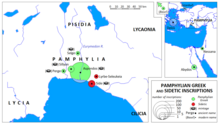Digamma or wau is an archaic letter of the Greek alphabet. It originally stood for the sound but it has remained in use principally as a Greek numeral for 6. Whereas it was originally called waw or wau, its most common appellation in classical Greek is digamma; as a numeral, it was called episēmon during the Byzantine era and is now known as stigma after the Byzantine ligature combining σ-τ as ϛ.

Pamphylia was a region in the south of Asia Minor, between Lycia and Cilicia, extending from the Mediterranean to Mount Taurus. It was bounded on the north by Pisidia and was therefore a country of small extent, having a coast-line of only about 120 km with a breadth of about 50 km. Under the Roman administration the term Pamphylia was extended so as to include Pisidia and the whole tract up to the frontiers of Phrygia and Lycaonia, and in this wider sense it is employed by Ptolemy.

Attic Greek is the Greek dialect of the ancient region of Attica, including the polis of Athens. Often called classical Greek, it was the prestige dialect of the Greek world for centuries and remains the standard form of the language that is taught to students of ancient Greek. As the basis of the Hellenistic Koine, it is the most similar of the ancient dialects to later Greek. Attic is traditionally classified as a member or sister dialect of the Ionic branch.

Ionic or Ionian Greek was a subdialect of the Eastern or Attic–Ionic dialect group of Ancient Greek. The Ionic group traditionally comprises three dialectal varieties that were spoken in Euboea, the northern Cyclades, and from c. 1000 BC onward in Asiatic Ionia, where Ionian colonists from Athens founded their cities. Ionic was the base of several literary language forms of the Archaic and Classical periods, both in poetry and prose. The works of Homer and Hesiod are among the most popular poetic works that were written in a literary form of the Ionic dialect, known as Epic or Homeric Greek. The oldest Greek prose, including that of Heraclitus, Herodotus, Democritus, and Hippocrates, was also written in Ionic. By the end of the 5th century BC, Ionic was supplanted by Attic, which had become the dominant dialect of the Greek world.

Ancient Greek includes the forms of the Greek language used in ancient Greece and the ancient world from around 1500 BC to 300 BC. It is often roughly divided into the following periods: Mycenaean Greek, Dark Ages, the Archaic or Epic period, and the Classical period.
Sampi is an archaic letter of the Greek alphabet. It was used as an addition to the classical 24-letter alphabet in some eastern Ionic dialects of ancient Greek in the 6th and 5th centuries BC, to denote some type of a sibilant sound, probably or, and was abandoned when the sound disappeared from Greek.

San (Ϻ) was an archaic letter of the Greek alphabet. Its shape was similar to modern M or Mu, or to a modern Greek Sigma (Σ) turned sideways, and it was used as an alternative to Sigma to denote the sound. Unlike Sigma, whose position in the alphabet is between Rho and Tau, San appeared between Pi and Qoppa in alphabetic order. In addition to denoting this separate archaic character, the name San was also used as an alternative name to denote the standard letter Sigma.

In linguistics, Aeolic Greek, also known as Aeolian, Lesbian or Lesbic dialect, is the set of dialects of Ancient Greek spoken mainly in Boeotia; in Thessaly; in the Aegean island of Lesbos; and in the Greek colonies of Aeolis in Anatolia and adjoining islands.

Aspendos or Aspendus was an ancient Greco-Roman city in Antalya province of Turkey. The site is located 40 km east of the modern city of Antalya.

Mycenaean Greek is the most ancient attested form of the Greek language, on the Greek mainland and Crete in Mycenaean Greece, before the hypothesised Dorian invasion, often cited as the terminus ad quem for the introduction of the Greek language to Greece. The language is preserved in inscriptions in Linear B, a script first attested on Crete before the 14th century BC. Most inscriptions are on clay tablets found in Knossos, in central Crete, as well as in Pylos, in the southwest of the Peloponnese. Other tablets have been found at Mycenae itself, Tiryns and Thebes and at Chania, in Western Crete. The language is named after Mycenae, one of the major centres of Mycenaean Greece.

Arcadocypriot, or southern Achaean, was an ancient Greek dialect spoken in Arcadia in the central Peloponnese and in Cyprus. Its resemblance to Mycenaean Greek, as it is known from the Linear B corpus, suggests that Arcadocypriot is its descendant.
Ancient Macedonian was the language of the ancient Macedonians which was either a dialect of Ancient Greek or a separate Hellenic language. It was spoken in the kingdom of Macedonia during the 1st millennium BC and belonged to the Indo-European language family. It gradually fell out of use during the 4th century BC, marginalized by the use of Attic Greek by the Macedonian aristocracy, the Ancient Greek dialect that became the basis of Koine Greek, the lingua franca of the Hellenistic period. It became extinct during either the Hellenistic or Roman imperial period, and was entirely replaced by Koine Greek.

Ancient Greek in classical antiquity, before the development of the common Koine Greek of the Hellenistic period, was divided into several varieties.
Ancient Greek phonology is the reconstructed phonology or pronunciation of Ancient Greek. This article mostly deals with the pronunciation of the standard Attic dialect of the fifth century BC, used by Plato and other Classical Greek writers, and touches on other dialects spoken at the same time or earlier. The pronunciation of Ancient Greek is not known from direct observation, but determined from other types of evidence. Some details regarding the pronunciation of Attic Greek and other Ancient Greek dialects are unknown, but it is generally agreed that Attic Greek had certain features not present in English or Modern Greek, such as a three-way distinction between voiced, voiceless, and aspirated stops ; a distinction between single and double consonants and short and long vowels in most positions in a word; and a word accent that involved pitch.

The history of the Greek alphabet starts with the adoption of Phoenician letter forms in the 9th–8th centuries BC during early Archaic Greece and continues to the present day. The Greek alphabet was developed during the Iron Age, centuries after the loss of Linear B, the syllabic script that was used for writing Mycenaean Greek until the Late Bronze Age collapse and Greek Dark Age. This article concentrates on the development of the alphabet before the modern codification of the standard Greek alphabet.
The Mysian language was spoken by Mysians inhabiting Mysia in north-west Anatolia.
The Proto-Ionians are the hypothetical earliest speakers of the Ionic dialects of Ancient Greek, chiefly in the works of Jean Faucounau. The relation of Ionic to the other Greek dialects has been subject to some debate. It is mostly grouped with Arcadocypriot as opposed to Doric, reflecting two waves of migration into Greece following the Proto-Greek period, but sometimes also as separate from Arcadocypriot on equal footing with Doric, suggesting three distinct waves of migration.
The Sidetic language is a member of the extinct Anatolian branch of the Indo-European language family known from legends of coins dating to the period of approximately the 5th to 3rd centuries BCE found in Side at the Pamphylian coast, and two Greek–Sidetic bilingual inscriptions from the 3rd and 2nd centuries BCE respectively. The Greek historian Arrian in his Anabasis Alexandri mentions the existence of a peculiar indigenous language in the city of Side. Sidetic was probably closely related to Lydian, Carian and Lycian.
In Ancient Greek, all nouns are classified according to grammatical gender and are used in a number. According to their function in a sentence, their form changes to one of the five cases. The set of forms that a noun will take for each case and number is determined by the declension that it follows.

Many local variants of the Greek alphabet were employed in ancient Greece during the archaic and early classical periods, until around 400 BC, when they were replaced by the classical 24-letter alphabet that is the standard today. All forms of the Greek alphabet were originally based on the shared inventory of the 22 symbols of the Phoenician alphabet, with the exception of the letter Samekh, whose Greek counterpart Xi (Ξ) was used only in a sub-group of Greek alphabets, and with the common addition of Upsilon (Υ) for the vowel. The local, so-called epichoric, alphabets differed in many ways: in the use of the consonant symbols Χ, Φ and Ψ; in the use of the innovative long vowel letters, in the absence or presence of Η in its original consonant function ; in the use or non-use of certain archaic letters ; and in many details of the individual shapes of each letter. The system now familiar as the standard 24-letter Greek alphabet was originally the regional variant of the Ionian cities in Anatolia. It was officially adopted in Athens in 403 BC and in most of the rest of the Greek world by the middle of the 4th century BC.









